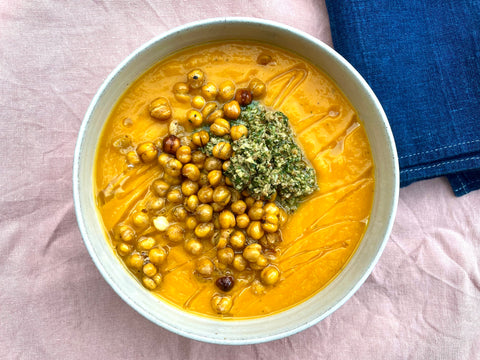
As the weather starts to cool down, we wanted to share with you one of our favourite Adelaide winter rituals: enjoying a warm cup of homemade bone broth as an afternoon pick-me-up.
One of bone broth's key components is collagen, a structural protein abundant in bones, skin, and connective tissues. When you simmer bones in water for an extended period, collagen breaks down into gelatin, a substance known for its ability to promote gut health, joint function, and skin elasticity.
Collagen and gelatin are rich in amino acids, including proline, glycine, hydroxyproline, and glutamine. These amino acids play crucial roles in maintaining and repairing tissues throughout the body. For instance, glycine is involved in forming collagen, promoting wound healing, and supporting liver function. Proline contributes to the integrity of skin, joints, and blood vessels, while hydroxyproline is essential for collagen stability. Glutamine, another key amino acid found in collagen and gelatin, plays a vital role in supporting gut health by promoting mucosal healing and maintaining the integrity of the gut lining
Additionally, bone broth contains minerals like calcium, magnesium, phosphorus, and potassium, which are important for bone strength, nerve function, and electrolyte balance. These minerals are released from the bones during the simmering process, making bone broth a natural source of bioavailable nutrients.
One of the reasons we love having bone broth on hand is its versatility. You can enjoy it on its own as a nourishing beverage or use it as a base for soups, cook veggies in it, or add it to rice when it is cooking. It adds a lovely depth of flavour to meals.
Here is the recipe:
- 1-1.5 kilograms of organic & grass fed beef bones (go for the good stuff, like marrow bones or knuckle bones). We usually have these in the chest freezer located in the back right of the store.
- 2 onions, quartered
- 3 carrots, roughly chopped
- 3 celery stalks, chopped
- 4 garlic cloves, smashed
- 2 bay leaves
- A handful of fresh parsley
- 1 tablespoon of whole black peppercorns
- 2 star anise pods
- 2 tablespoons of organic apple cider vinegar
- Water, enough to cover everything in the slow cooker
Now, let's get cooking:
- Start by turning on your slow cooker to the low setting, getting it all warmed up.
- Pop those beautiful organic beef bones into the slow cooker, then add in the onions, carrots, celery, garlic, bay leaves, parsley, peppercorns, star anise pods, and a good splash of organic apple cider vinegar.
- Pour in enough water to cover all the ingredients – this is where the magic happens.
- Pop the lid on, set it and forget it! Let it simmer away on low heat for a good 12 to 24 hours. The longer, the better – we're aiming for a broth that's rich, flavorful, and packed with nutrients.
- Once your broth has had its time to work its magic, strain it through a fine sieve or cheesecloth into a big bowl or pot.
- Say goodbye to those bones and veggies – they've done their job, you can even enjoy the tender meat if you like, or if you have a furry friend like mine, share it as a nutritious treat for them too! Let the broth cool down a bit.
You should find that your bone broth is almost like jelly - it should wobble - and you'll notice a layer of fat on the top. Don't worry, that's good stuff!
When you reheat the broth, the fat will melt down, adding richness and flavour.
The importance is finding good-quality organic bones. If you feel you don't have time to make it at home a good store bought alternative is the Best of the Bones broth where you just add water. If you're going to use Best of the Bone in your cooking, just use a little less salt as it's already pretty salty.
Enjoy your bone broth adventure!




Comments (0)
There are no comments for this article. Be the first one to leave a message!